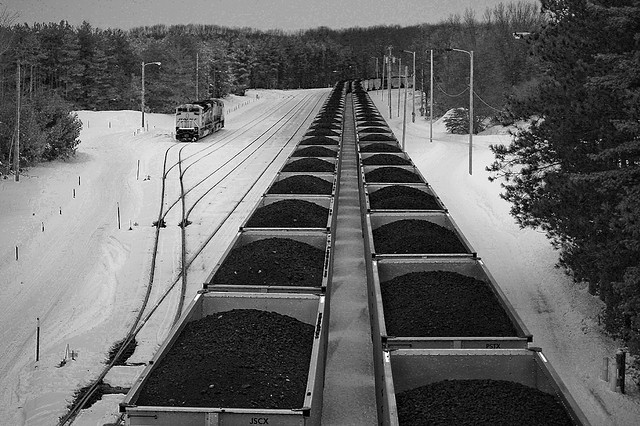Podcast: Play in new window | Download
Subscribe: RSS

A coal train once supplied the city of Holland, Michigan with fuel for its electric generating plant. They converted the plant to natural gas. Their costs are down, their emissions are down, and coal is down for the count. (Photo by wsilver/Flickr)
After bestriding the mountains of Appalachia, among many other places, like the proverbial Colossus for a century and more, the U.S. coal industry has been taken to hospice, a pathetic wasted shadow of its former self, its physical condition terminal, its thought processes derailed by dementia. It’s not a pretty sight (except perhaps to the survivors of the ruin, destruction and death it has brought to thousands upon thousands of helpless people) and there are those who say its fate foreshadows that of the oil fracking industry, which is now in the ICU, and the legacy oil bidness, which has started to have dizzy spells and occasional sudden hemorrhaging.
A report out this week from the think tank Carbon Tracker, titled “The U.S. Coal Crash,” itemizes the problems listed on the patient’s chart:
- 26 coal companies bankrupt in the last three years;
- Peabody Energy Corp., the world’s largest private coal company, has lost 80% of its share value, and that is representative of the industry as a whole (or as a hole);
- 264 mines were closed in just two years — 2011-2013.
- The last best hope for coal, China, which burns more than the rest of the world combined, has rendered much of its territory including its capital virtually uninhabitable because of the resulting air pollution, and is cutting back. A little. Down 3% last year.
Oh, and the dementia part? Peabody Energy issued a “forecast” this year “foreseeing” increased coal demand of 10-30 million tons, and global demand increasing by 500 million tons. Not only that, but the industry professes to believe in “clean” coal, and that its woes are caused entirely by President Obama’s “war on coal.” It’s sad, really, next we’ll find them wandering in the WalMart parking lot, unable to remember where they put their car.
What the industry calls the “war on coal” — the U.S. government’s limp-wristed efforts to reduce air pollution before it a) boils the planet and b) makes all the monuments in Washington invisible, like the skyline of Beijing — is not the primary cause of the industry’s demise. That mortal wound was delivered by the natural gas frackers, who in 2008 began to flood the market with cheap, fracked gas and inspired every electric generating plant that could do it to convert to burning gas instead of coal.
There went coal’s last reliable market, and that is why the doctors expect to see a flat line on the monitor any day now. Incidentally, the gas frackers did so well at driving down the price of their product that many of them went under, too, and the rest are hanging on with teeth and fingernails. You can’t get poetic justice to rhyme any better than that.
You’ve heard of those people who get diagnosed as terminal, check into hospice, and five years later get kicked out because they refuse to die? Coal will probably be like that for the remainder of the Industrial Age. It will remain the cheapest option for some, and cheap trumps everything else in our values-deprived world. Same with oil. It will endure long past its prime, in palliative care.
Yes, the mighty are falling, and it’s hard not to gloat, until we remember their ultimate justification: they were only giving us what we wanted.
The quality of coal has been declining and the cost of extracting coal has been rising, too, so that it is barely profitable to move it around, as Richard Heinberg writes in his book Blackout, and David Roberts notes on grist.org: http://grist.org/climate-energy/big-coal-in-big-trouble-as-coal-production-costs-rise/
I was going to say that the EROI on coal has been on the rise and thus–just like oil–the ability of customers to pay for it is slowly eroding at a time when the cost of digging for it is rising. When those two lines cross, the industry will collapse altogether.
There are no solutions to the current crises to be found within “the box” of comfortable operating procedure. All genuine solutions require a massive reorganization of such proportions that no will exists to implement them.
Externalized cost is catching up, no, HAS caught up with game of the modern merchant class.
There are many signs that we are facing an immediate collapse, one of the most poignant being the willingness of supposedly rational individuals-esp. those in power-to retreat into delusions, and then expect everyone to embrace their delusions.
Perhaps the most sane thing is just to get out of the way of all those blocks and beams that are snapping, groaning, and about to come raining down.
More on the collapse of coal – a similar situation, it seems, to shale gas – prices are dropping, yet they’re still producing, because they can’t afford to stop:
http://www.msn.com/en-us/money/companies/appalachia-miners-wiped-out-by-coal-glut-they-cant-reverse/ar-AAaeEPe